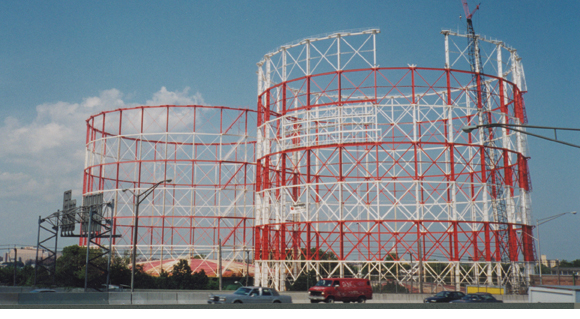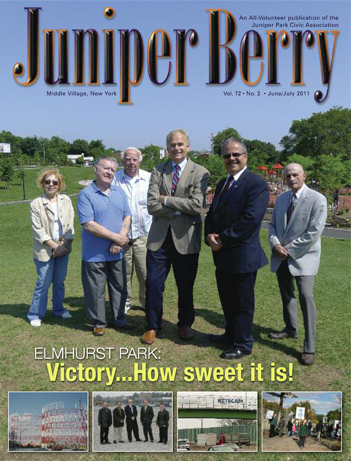August, 1996:
Keyspan begins dismantling the Elmhurst Gas Tanks. Tells community it will use land for storage of vehicles.
September, 2001:
Keyspan announces plans to sell Elmhurst Gas Tanks Property.
August 21, 2002: First JPCA/Keyspan meeting -Ad Hoc committee formed.
September 19, 2002:
50 entities have expressed interest in purchasing the Elmhurst Gas Tanks site, which is zoned M-3 (heavy manufacturing), land appraised at about $13 million. Representatives from Petracca & Sons present their commercial plan at JPCA Town Meeting. They plan retail stores and a 1,200-car parking lot on the site. Many meeting attendees want a park.
October 5, 2002:
The Juniper Park Civic Assoc. distributes over 800 surveys to residents living within 1/4 mile radius of the Elmhurst Gas Tanks site. Just over 500 are returned. Results: 367 people want a park, 79 want residential, 18 want a mall and only 10 want a superstore.
October 24, 2002:
Keyspan sends Scott Panzer of Newmark Realty to represent them at JPCA Town Meeting. He shows three development plans then proceeds to push for a Home Depot. Manny Caruana of Maspeth says he has a problem when a real estate agent speaks on behalf of Keyspan. Bob Holden suggests Keyspan donate the site and make it a park. Panser said that the Public Service Commission would not permit Keyspan to donate the property. Holden blasts Keyspan not coming to the community before starting the process. “How dare Keyspan even suggest building a Home Depot, ”said Holden. Panser fires back saying that he is giving realistic solutions to the development and warned the crowd not to be misled and fired up by rhetoric.
November 13, 2002:
David Manning, Keyspan’s VP for Corporate Affairs makes presentation to Community Board 5. Several board members object to Keyspan’s handling of the proposed sale. Board member Tony Nunziato tells Manning… “For almost 100 years we’ve suffered with the eyesore of those ugly tanks… we’ve paid for your service and you profited from us. By selling it and not giving the land to the community you’re disposing of our quality of life.”
November 22, 2002:
Offer of purchase is made to Keyspan by a joint venture of Mattone Group and Starwood Ceruzzi.
December 2002:
Keyspan accepts the Mattone Group Starwood Ceruzzi offer that calls for a big box development. Mattone group lines up Home Depot as major tenant.
March 28, 2003:
Keyspan agrees to postpone the sale of the property until the end of 2003 in order to give elected officials time to see if any funds can be found to purchase the land.
April 3, 2003:
Keyspan informs Mattone Group that they have entered an agreement with elected officials that provided them the opportunity to acquire the property up to December 31, 2003. However an agreement with Keyspan was reached whereby the Mattone Group would complete negotiations with KeySpan on the Purchase and Sale Agreement.
June 30, 2003:
Contract negotiations complete with Keyspan and Mattone Group.
July 2003:
Developer Joseph Mattone meets with Congressman Joseph Crowley and State Senator Serf Maltese to inform them of the deal. Shows them blueprints of the proposed Home Depot. Both Crowley and Maltese tell Mattone that there’s no money to purchase the land. However both never contact the community or the JPCA to inform them of the Keyspan-Mattone contract.
September 8, 2003:
Joseph Mattone and Doug MacLaury, a Mattone senior vice president, arrange a meeting with JPCA President Bob Holden. Mattone tells Holden that they have signed a contract with Keyspan and plan to build a Home Depot, a Self Storage Company and a Commerce Bank on the Elmhurst Gas Tanks Property. They prepare a packet for Holden containing some language of the contract, plans and facts and figures as to why the land will not be a park. Mattone wants to start construction on the Home Depot before the Dec. 31st deadline to beat the winter freeze. Tells Holden he will give JPCA nearly an acre of land for agreeing to Home Depot. Holden immediately goes back to the Juniper Civic office writes a press release about Keyspan’s double dealing. MacLaury later tells a Ridgewood Ledger reporter…We went in to try to work with (Holden), and the next day it’s splattered all over the newspapers.
The fight is On!
September 18, 2003:
Hurricane threat, JPCA Town Meeting goes on. Over 150 residents braved the elements. Draped on either side of the JPCA banner are signs that read, “No Home Depot: Keyspan Too Big to Care.”
September 19, 2003:
Bob Holden forms Community Task Force to deal with Keyspan problem. First meeting at Maspeth Federal Savings offices.
September 26, 2003:
Task Force meets with Keyspan representatives on environmental issues. Former City Councilman Tom Ognibene joins Task Force. Keyspan refuses to send company executives to meeting. Task Force breaks off negotiations with Keyspan. Vows to stage protests.
October 6, 2003:
Monthly meeting of COMET (Citizens of Maspeth and Elmhurst Together). COMET leadership opposes a protest and rally. Some of the members support Big Box and others want a strip mall. Councilman Gallagher encourages COMET to join the fight for a park. Leadership of COMET says no, some independent members join the coalition.
October 9, 2003:
First Task Force Town Meeting at P.S.58 in Maspeth. Residents voice opposition. Display signs such as: “Keyscam,” “No Home Depot,” Keyspan…Too Big to Care.” Holden opened the meeting by stating, Anyone who says we can’t win this fight doesn’t know the JPCA and doesn’t know Maspeth. Tony Nunziato said, …It’s time to say… enough. It’s time to say, let’s boycott, and shut off our gas together. Councilman Dennis Gallagher and State Senator Serf Maltese are the only elected officials to appear at meeting. Residents upset that more elected officials are not present.
October 16, 2003:
JPCA Executive Board meeting, Task Force members invited to attend. JPCA sets date for first protest demonstration. Buses also ready for demonstration at Keyspan headquarters in Brooklyn. JPCA Board and Task Force demand that elected officials pressure Keyspan.
October 22, 2003:
Former Councilman Tom Ognibene, a Task Force member, writes a letter to Mayor Bloomberg asking the Mayor to get involved in the Elmhurst Gas Tanks site issue.
October 23, 2003:
Over 400 residents attend JPCA meeting with elected officials. All are united in the effort to stop a Home Depot.
October 27, 2003:
Council Member Dennis Gallagher meets with John Crotty, the Mayor’s Director of Legislative Affairs. Crotty asks about Ognibene’s letter to the Mayor.
October 29, 2003:
Mayor Bloomberg contacts Bob Catell, the CEO of KeySpan and Catell agreed in principle to accept the City’s offer to purchase the land.
October 30, 2003:
Mayor Bloomberg attends Councilman Gallagher’s fundraiser and announces that the Elmhurst Gas Tanks site should not be a Home Depot. “We need open space,” says the Mayor.
November 4, 2003:
Two 30’ banners are strung over the Long Island Expressway with the word: KEYSCAM. The Queens Chronicle newspaper reports that the culprits were unknown.
November 6, 2003:
Bob Holden calls former Councilman Tom Ognibene and asks him to contact Keyspan on behalf of the Task Force. Deputy Mayor Doctoroff, reaches out to Holden and asks that the Community Task Force tone down the Keyscam rhetoric. After consulting with Tony Nunziato and Manny Caruana, Holden says the Task Force will tone it down when Keyspan reaches an agreement with the City and the community has it in writing. Holden says that the Task Force will still go ahead with Saturday’s protest unless an agreement is reached.
November 7, 2003:
On the Mayor’s weekly radio show with John Gambling the Mayor announced that a deal had been made with KeySpan and that the Mattone contract for building of Home Depot would be null and void.
November 8, 2003: Instead of a protest residents cheer as Deputy Mayor Doctoroff makes the announcement to 300 residents who had gathered on the cold and windy Saturday morning. Doctoroff breaks champagne bottle (photo, far left) given to him by JPCA’s Margaret Magnus.
November 10, 2003:
Mayor Bloomberg visits Elmhurst Gas Tanks site with Parks Commissioner Adrian Benepe. This was a victory for all communities and a victory that should motivate citizens of New York City that they do have something to say about protecting the quality of life of their neighborhoods.
March 2006:
Construction begins on phase I of Elmhurst Park.
April 2011:
6.5 acre Elmhurst Park opens to rave reviews!
June 6, 2011:
Mayor Bloomberg cuts ribbon to officially Elmhurst Park. How sweet it is!




